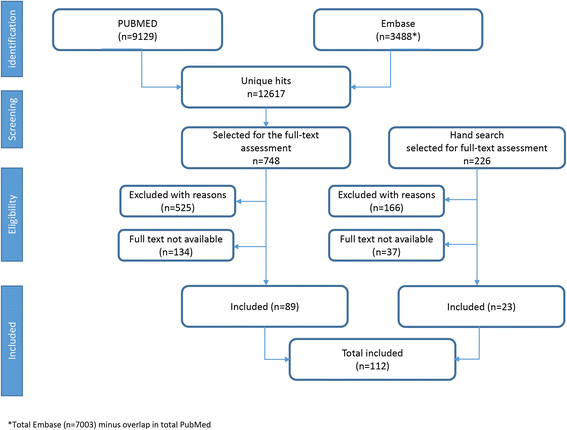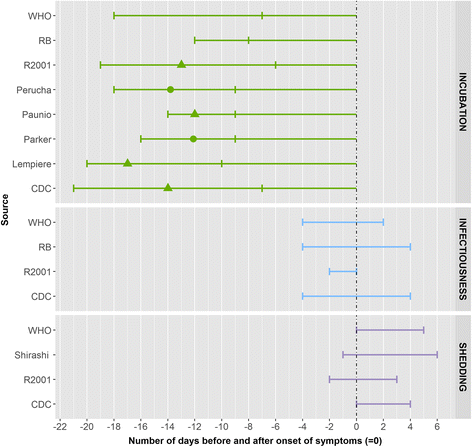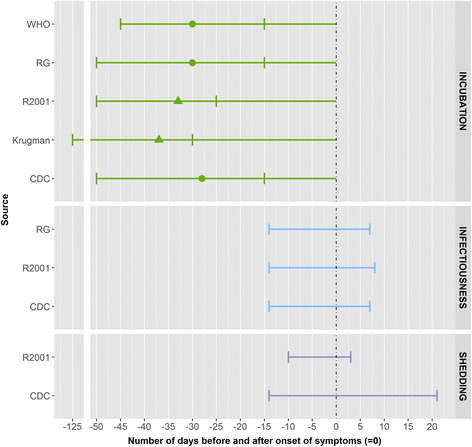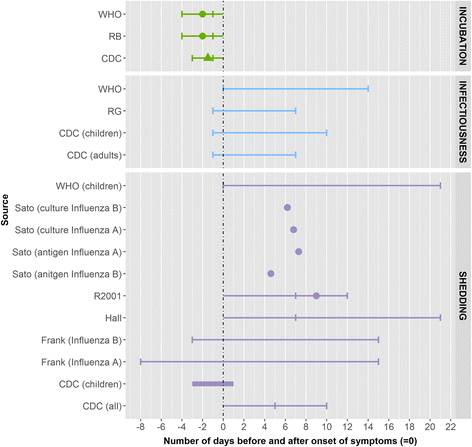Management and control of communicable diseases in schools and other child care settings: systematic review on the incubation period and period of infectiousness
- PMID: 29716545
- PMCID: PMC5930806
- DOI: 10.1186/s12879-018-3095-8
Management and control of communicable diseases in schools and other child care settings: systematic review on the incubation period and period of infectiousness
Abstract
Background: Information on the incubation period and period of infectiousness or shedding of infectious pathogens is critical for management and control of communicable diseases in schools and other childcare settings.
Methods: We performed a systematic literature review (Pubmed and Embase) to identify and critically appraise all relevant published articles using incubation, infectiousness or shedding, and exclusion period as parameters for the search. No language, time, geographical or study design restrictions were applied.
Results: A total of 112 articles met the eligibility criteria. A relatively large number were retrieved for gastrointestinal diseases and influenza or respiratory syncytial virus, but there were few or no studies for other diseases. Although a considerable number of publications reported the incubation and shedding periods, there was less evidence concerning the period of infectiousness. On average, five days of exclusion is considered for measles, mumps, rubella, varicella and pertussis. For other diseases, such as most cases of meningococcal disease, hepatitis A and influenza exclusion is considered as long as severe symptoms persist. However, these results are based on a diverse range of study characteristics, including age, treatment, vaccination, underlying diseases, diagnostic tools, viral load, study design and definitions, making statistical analysis difficult.
Conclusions: Despite inconsistent definitions for key variables and the diversity of studies reviewed, published data provide sufficient quantitative estimates to inform decision making in schools and other childcare settings. The results can be used as a reference when deciding about the exclusion of a child with a communicable disease that both prevents exposure and avoids unnecessary absenteeism.
Keywords: Infectious diseases; Measles; Mumps; Pertussis; Rubella; Varicella.
Conflict of interest statement
Ethics approval and consent to participate
Not applicable (literature review).
Competing interests
The authors declare that they have no competing interests.
Publisher’s Note
Springer Nature remains neutral with regard to jurisdictional claims in published maps and institutional affiliations.
Figures


 : minimum and maximum range, RB: Red Book, R2001: Richardson et al. (2001)
: minimum and maximum range, RB: Red Book, R2001: Richardson et al. (2001)
 : minimum and maximum range, RB: Red Book, R2001: Richardson et al. (2001), RG: The 2009 ‘Managing infectious diseases in child care and school. A quick reference guide’
: minimum and maximum range, RB: Red Book, R2001: Richardson et al. (2001), RG: The 2009 ‘Managing infectious diseases in child care and school. A quick reference guide’
 : minimum and maximum range, RB: Red Book, R2001: Richardson et al. (2001)
: minimum and maximum range, RB: Red Book, R2001: Richardson et al. (2001)
 : minimum and maximum range, RB: Red Book, R2001: Richardson et al. (2001)
: minimum and maximum range, RB: Red Book, R2001: Richardson et al. (2001)
 minimum and maximum range, RB: Red Book, R2001: Richardson et al. (2001), RG: The 2009 ‘Managing infectious diseases in childcare and school. A quick reference guide’
minimum and maximum range, RB: Red Book, R2001: Richardson et al. (2001), RG: The 2009 ‘Managing infectious diseases in childcare and school. A quick reference guide’
 minimum and maximum range, RB: Red Book, R2001: Richardson et al. (2001)
minimum and maximum range, RB: Red Book, R2001: Richardson et al. (2001)
 minimum and maximum range, RB: Red Book, R2001: Richardson et al. (2001), RG: The 2009 ‘Managing infectious diseases in child care and school. A quick reference guide’
minimum and maximum range, RB: Red Book, R2001: Richardson et al. (2001), RG: The 2009 ‘Managing infectious diseases in child care and school. A quick reference guide’
 minimum and maximum range, RB: Red Book, R2001: Richardson et al. (2001), RG: The 2009 ‘Managing infectious diseases in child care and school. A quick reference guide’
minimum and maximum range, RB: Red Book, R2001: Richardson et al. (2001), RG: The 2009 ‘Managing infectious diseases in child care and school. A quick reference guide’References
-
- Sharland M. The blue book: manual of childhood infections. 3. Oxford: Oxford University Press; 2011.
-
- Richardson M, Elliman D, Maguire H, Simpson J, Nicoll A. Evidence base of incubation periods, periods of infectiousness and exclusion policies for the control of communicable diseases in schools and preschools. Pediatr Infect Dis J. 2001;20(4):380–391. doi: 10.1097/00006454-200104000-00004. - DOI - PubMed
-
- European Centre for Disease Prevention and Control . Systematic review on the incubation and infectiousness/shedding period of communicable diseases in children. Stockholm: ECDC; 2016.
Publication types
MeSH terms
LinkOut - more resources
Full Text Sources
Other Literature Sources
Medical
Miscellaneous

